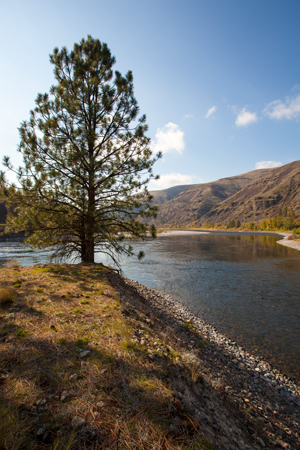Clearwater River near Cottonwood Creek

Photo © 2013 Kris Townsend
September 20, 1805, the Corps of Discovery met the Nez Perce Indians on the Weippe Prairie. The next day, Clark and his hunters traveled to the Clearwater River. Clark arrived on the Clearwater River about 11:30 PM. This site is about ½ mile upstream from Orofino, Idaho. Here he met an Indian Chief he called "Twisted Hair."
September 22, Clark and Twisted Hair returned to Weippe where they met with Lewis. They traveled back to the river and were finally all together at Canoe Camp on September 26, 1805. It is the only camp that Lewis & Clark named in Idaho.
They built five canoes at this camp, and left 38 horses with Twisted Hair to care for throughout the winter. Twisted Hair and another Indian, Tetoharsky, agreed to accompany the Corps to the falls on the Columbia River (Celio Falls).
October 7, the canoes were completed, supplies loaded, and they left Canoe Camp at 3:00 PM. Twisted Hair and Tetoharsky failed to be there to leave with them. They camped on the north side of the river near the present-day town of Lenore.
October 8, the two Chiefs who had agreed to accompany them were at a village near Cottonwood Creek (Clark named it Two Chiefs Creek). The two Chiefs boarded the canoes. These two chiefs accompanied the Expedition to the Celilo Falls, as they had agreed.
October 24, Clark wrote that the two old Chiefs wanted to return to their bands. "They could be of no further service to us, as their nation extended no further down the river than those falls, and as the nation below had expressed hostile intentions against us, would certainly kill them; perticuly as they had been at war with each other."
October 25, Clark wrote that they had "a parting smoke with our two faithful chiefs who had accompanied us from the head of the river." The Chiefs had each purchased a horse with 2 robes, and intended to return on horseback.
In addition to Twisted Hair and Tetoharsky, there were three Indians that piloted the Expedition from Lewiston, Idaho, to the Columbia River. These pilots furnished their own canoe.
October 12, 1805, Clark wrote, "we passed today rapids several of them very bad and came to at the head of one (at 30 miles) on the stard. Side to view it befor we attemptd. to dcend through it. The Indians had told us was very bad -we found long and dangerous about 2 miles in length, and maney turns necessary to Stear Clare of the rocks, which appeared to be in every direction. The Indians went through and our small canoe followed."
October 15, Clark wrote "we over took the three Indians who had piloted us thro the rapids from the forks." Apparently, "the forks" was the forks of the Clearwater and Snake River.
In 1805, at least two Nez Perce traveled overland from the Lewiston-Clarkston area to the Columbia River ahead of the Lewis and Clark Expedition.
Very little information was recorded in the men's journals about the Indians who traveled overland. On October 15, Clark wrote "Met two men who passed us several day ago."
May 3, 1806, on the return trip, the Expedition was on Pataha Creek in Garfield County, Washington. Here, they met a chief who they usually called Big Horn Chief. He always wore a horn of that animal suspended by a cord to his left arm. Apparently, they understood his name to be "We-ark-koomt." His name was Apash Wyakaikt, or Flint Necklace."
Lewis wrote, "this man went down Lewis's river by land as we decended it by water last fall quite to the Columbia and I believe was very instrumental in procuring us a hospitable and friendly reception among the natives."
The Nimiipu (Nez Perce) Indians had proven to be faithful friends, navigators and ambassadors to the Expedition from near Lewiston, Idaho, to the Dalles, Oregon.
To learn more, read Lewis and Clark among the Nez Perce: Strangers in the Land of the Nimiipuu by Allen V. Pinkham and Steven R. Evans (The Dakota Institute Press, 2013).—Ed.
Information from the Journals of Lewis & Clark Expedition, Gary E. Moulton, Editor, University of Nebraska Press.